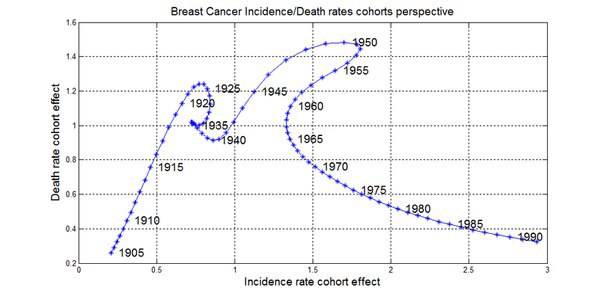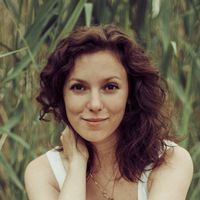Никто не поймет, чего понаписано, но график мне так понравился, что я подумал о нем написать.
История об ужасах СССР.
Это график взаимозависимости влияния/эффекта когорты(года рождения) на заболеваемость (ось X) и смертность (ось Y) для рака груди.
(Тут надо еще учесть, что эффект возраста тут учтен и убран. Т.е. это эффект того, что с возрастом и заболеть и умереть проще от любой болезни)
Так вот. Для людей(женщин) с 1905 по 1920 год рождения заболеваемость и смертность вместе росли. То есть, и лечить не умели и общее здоровье поколения падало. Потом была какая-то хрень с 25 по 50. 50 год рождения это самая "опасная" когорта, где и смертность наибольшая. Потом и (когортная) смертность и (когортная) заболеваемость до 65 года падали. А потом начала расти заболеваемость, а смертность продолжала уменьшаться... То есть, у женщин 70 года несколько меньше шансов заболеть РМЖ, чем у женщин 90-года рождения, но больше шансов от него умереть (правда не настолько, насколько больше шансов заболеть, у поколения 90-го года).
Все все поняли.
Я верю.
История об ужасах СССР.
Это график взаимозависимости влияния/эффекта когорты(года рождения) на заболеваемость (ось X) и смертность (ось Y) для рака груди.
(Тут надо еще учесть, что эффект возраста тут учтен и убран. Т.е. это эффект того, что с возрастом и заболеть и умереть проще от любой болезни)
Так вот. Для людей(женщин) с 1905 по 1920 год рождения заболеваемость и смертность вместе росли. То есть, и лечить не умели и общее здоровье поколения падало. Потом была какая-то хрень с 25 по 50. 50 год рождения это самая "опасная" когорта, где и смертность наибольшая. Потом и (когортная) смертность и (когортная) заболеваемость до 65 года падали. А потом начала расти заболеваемость, а смертность продолжала уменьшаться... То есть, у женщин 70 года несколько меньше шансов заболеть РМЖ, чем у женщин 90-года рождения, но больше шансов от него умереть (правда не настолько, насколько больше шансов заболеть, у поколения 90-го года).
Все все поняли.
Я верю.
No one will understand what has been written, but I liked the schedule so much that I thought to write about it.
The story of the horrors of the USSR.
This is a graph of the interdependency of cohort (year of birth) effect / effect on morbidity (X axis) and mortality (Y axis) for breast cancer.
(Here we must also take into account that the effect of age is taken into account and cleaned here. That is, this is the effect of the fact that with age it is easier to get sick and die from any disease)
So here. For people (women) from 1905 to 1920, the incidence and mortality increased together. That is, they did not know how to heal and the general health of the generation fell. Then there was some kind of crap from 25 to 50. 50 year of birth is the most "dangerous" cohort, where the death rate is greatest. Then, both (cohort) mortality and (cohort) morbidity fell to 65 years. And then the incidence began to grow, and the mortality rate continued to decrease ... That is, women in their 70s are slightly less likely to get breast cancer than women of 90-year-olds, but more likely to die from it (though not as much as they are more likely to get sick). the generation of the 90th year).
Everyone understood everything.
I believe.
The story of the horrors of the USSR.
This is a graph of the interdependency of cohort (year of birth) effect / effect on morbidity (X axis) and mortality (Y axis) for breast cancer.
(Here we must also take into account that the effect of age is taken into account and cleaned here. That is, this is the effect of the fact that with age it is easier to get sick and die from any disease)
So here. For people (women) from 1905 to 1920, the incidence and mortality increased together. That is, they did not know how to heal and the general health of the generation fell. Then there was some kind of crap from 25 to 50. 50 year of birth is the most "dangerous" cohort, where the death rate is greatest. Then, both (cohort) mortality and (cohort) morbidity fell to 65 years. And then the incidence began to grow, and the mortality rate continued to decrease ... That is, women in their 70s are slightly less likely to get breast cancer than women of 90-year-olds, but more likely to die from it (though not as much as they are more likely to get sick). the generation of the 90th year).
Everyone understood everything.
I believe.

У записи 12 лайков,
0 репостов.
0 репостов.
Эту запись оставил(а) на своей стене Александр Беспалов































